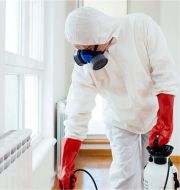
On average, humans contain 8 liters of blood. For someone who is infected with HIV or hepatitis, their body contains 8 liters of bio-hazardous fluid that must be contained and disinfected. People who are not infected pose a biohazard too. Human blood, whether it is carrying viruses or not, is rich in nutrients that bacteria will feed on. The gastrointestinal tract also contains many species of bacteria that assist in the digestion of food. Problems arise when these bacteria are no longer contained within the walls of the gut (i.e. an abdominal wound). Crime scene cleanup services use special technologies to test surfaces for the presence of human tissue or fluid. Without the ability to perform these tests it is unsafe to attempt any cleanup yourself.
The importance of disinfection
Crime scene cleanup itself is relatively simple. Most firms will use an FDA approved disinfector like chlorine dioxide. The chlorine dioxide is powerful enough to breakdown the protein structures and nucleic acid chains found in all human tissue and fluids, as well as all bacteria and viruses. Once all of this is eradicated, there will be no lingering viruses to be picked up under anybody’s shoe, nor will there be any bacteria, or food left behind for the bacteria to feed on.
Typical crime scene cleanup procedure will involve scrubbing and washing to dissolve away the contaminants. Then the disinfection will commence. After each round of disinfection, there will be ATP testing. Adenosine triphosphate (ATP) is an energy dense compound found in all living things (i.e. plant cells, animal cells, bacteria, viruses). If the test reveals any presence of ATP, it means that the surface is not fully clean. Sometimes after disinfection it can be that one single cell is still present. All it takes is one cell to cause problems.
What happens when DIY cleanup goes wrong
Suppose you try to clean things up yourself after a crime as occurred. You buy some PPE, get your hands on the chlorine dioxide, and get busy scrubbing. After 12 hours of hard work, everything appears to be clean. You breathe a sigh of relief. Over the next six months you are very preoccupied with PTSD. You go to the counselling and group therapy, fully immersed in the wilderness of grief. While all this is going on, you spend less time in the room where the event took place. You fail to notice the musky smell that started to develop, and the discoloring of the far wall that got the most blood spatter. After doing some reading online, you convince yourself that the discoloration is just a blood pigment stain, so you leave it alone. Eventually you work up the courage to paint over the stain, on the advice of your councillor. As you begin to paint, you notice a weak spot in the drywall. Now things have progressed from a crime scene cleanup to full-blown biohazard remediation.
It turns out that the wall discoloring was no stain at all. It was the early stages of a highly aggressive bacterial colony eating away at the drywall. Carbapenem-resistant Enterobacteriaceae (CRE) is a superbug that lives in the colon. During the traumatic event, some of this escaped from an abdominal wound. As thorough as your cleaning was, a trace amount of it was left behind on a baseboard. It then got into the drywall. Modern drywall is made of cellulose, which is plant based. Although it is treated with chemicals that make it resistant to breakdown by mold, this treatment is not sufficient to protect it from CRE. Now your entire home is a biohazard, and you will need a OHSA certified crew to perform remediation. They will come in with hazmat suits, remove the insulation, perform a bunch of ATP tests, and then install the new stuff. Had you waited any longer, the bacteria would have gone into the wooden studs and frame. In this case, the entire house must be demolished and taken away for safe disposal. Maybe it’s a good idea to have a professional crime scene cleanup team come in and do the ATP testing during the initial cleanup, just to be safe.
 Posted in
Posted in